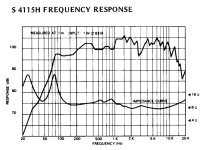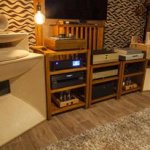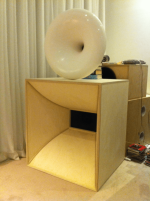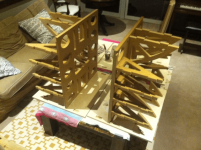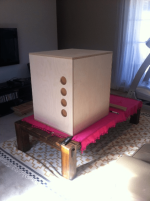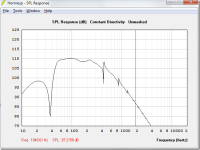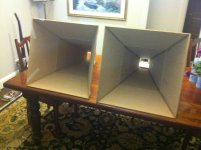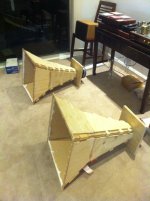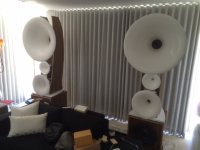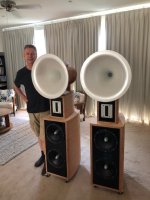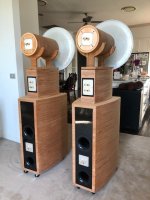As others have stated, the issue boils down to improved efficiency, where the driver has to work less to achieve the same output. This means more options re amplification. Of course, this is academic if you want to go with high powered amps. Secondly, the horn (or wave guide) will assist with directivity. This was particularly important for the Altec VOT, which was designed for small-medium sized theatres. There is also the issue that horns produce their own signature in sound.
I've built VOTT plus various other bass horns, including the 100Hz Inlow Sound horn, using the well-regarded 8-inch B&C 8PE21. The horn was approx 1m in length, sealed rear chamber, horn mouth approx 60cm x 60cm. Compression loading was approx 2:1. This horn is not intended for bass below, say, 100Hz. Regrettably, I did not have any active xover to test the best this horn could produce. It was paired with a Stereolabs stone composite 250Hz horn, 2-inch throat.
I've also designed my own bass horn, using Altec 415/515 woofer, with large 200 litre ported reflex cabinet. Horn Fs is approx 80Hz. This models well, and you have the best of both worlds. Use of CNC/CAD assists. Efficiency was pretty high, eg 98dB from memory. Top horn was Yuichi 290 (also my build using CNC), crossed at 500Hz using LR2 xover.
I've built VOTT plus various other bass horns, including the 100Hz Inlow Sound horn, using the well-regarded 8-inch B&C 8PE21. The horn was approx 1m in length, sealed rear chamber, horn mouth approx 60cm x 60cm. Compression loading was approx 2:1. This horn is not intended for bass below, say, 100Hz. Regrettably, I did not have any active xover to test the best this horn could produce. It was paired with a Stereolabs stone composite 250Hz horn, 2-inch throat.
I've also designed my own bass horn, using Altec 415/515 woofer, with large 200 litre ported reflex cabinet. Horn Fs is approx 80Hz. This models well, and you have the best of both worlds. Use of CNC/CAD assists. Efficiency was pretty high, eg 98dB from memory. Top horn was Yuichi 290 (also my build using CNC), crossed at 500Hz using LR2 xover.
Attachments
Nice bass horn there.
careful with the sims.
half space = horn mouth exiting from the middle of a floor or wall, not the box above in post 24 sitting on the floor....
I'd always wanted some 100hz front horns, looked closely at the b&c 8pe21 (up to 1khz?) and the 12"(600-700hz) .....
The mass corner is up there, not many woofers have the high FS and .2 qts needed for upper mid response for a horn.
https://yu-ra.tripod.com/horn.htm
I've always liked djk saying a bass horn needs to be half wavelength lower than the mouth.
Or 100hz mouth horn would need to be 1/4 wavelength of near 75hz, or 3.75' long.
careful with the sims.
half space = horn mouth exiting from the middle of a floor or wall, not the box above in post 24 sitting on the floor....
I'd always wanted some 100hz front horns, looked closely at the b&c 8pe21 (up to 1khz?) and the 12"(600-700hz) .....
The mass corner is up there, not many woofers have the high FS and .2 qts needed for upper mid response for a horn.
https://yu-ra.tripod.com/horn.htm
I've always liked djk saying a bass horn needs to be half wavelength lower than the mouth.
Or 100hz mouth horn would need to be 1/4 wavelength of near 75hz, or 3.75' long.
Attachments
Last edited:
Apologies, I was using the B&C 12PE32 in the 100Hz Inlow horn. I've used the B&C 8PE32 in Azura 160Hz horn in 4-way Cessarro/Avant Garde Trio-esq system. Ignore pic of large bass horn on top....that was for a fun photo/testing. Mid horn was Azura 340 and small horn 550....both driven by JBL. Bass was dual 18-inch Faital Pro in sealed walnut/ply cabs. MINIDsp used across all channels.
Attachments
profiguy - thanks for that!
atilsley - Awesome skills on display. Its like a factory finish on post 27, 29.
As for horns having signature sound, did you have a preference between your 200L ported reflex vs 100Hz Inlow ?
atilsley - Awesome skills on display. Its like a factory finish on post 27, 29.
As for horns having signature sound, did you have a preference between your 200L ported reflex vs 100Hz Inlow ?
Very nice work 👍Mid bass horn, including sim.
About the sim, What's the reason it only goes to ~200hz and drops off after that? Shouldn't it be able to do at least 500hz or more?
I have an exponential midbass horn designed by David Haigner from Vienna. The horn mouth has the dimensions of 118 cm width and 74 cm hight. The depth of the horn is 130 cm, the weight is about 180 kg.
The driver is an old friend: GPA 414/8. The horn is used in an active setup from 100 - 500 Hz and is supported by a low bass horn. The sound is completely effortless, easy-going and absolutely mesmerizing.
The compression ratio was deliberately chosen to be low: the horn throat has an area of 420 cm² for the 12" GPA driver.



The driver is an old friend: GPA 414/8. The horn is used in an active setup from 100 - 500 Hz and is supported by a low bass horn. The sound is completely effortless, easy-going and absolutely mesmerizing.
The compression ratio was deliberately chosen to be low: the horn throat has an area of 420 cm² for the 12" GPA driver.
Thank you for your kind remarks.profiguy - thanks for that!
atilsley - Awesome skills on display. Its like a factory finish on post 27, 29.
As for horns having signature sound, did you have a preference between your 200L ported reflex vs 100Hz Inlow ?
Unfortunately, I didn't have the chance to fully explore/test the Inlow horn, as I did not have any DSP. The Inlowsound horn is a "pure" horn, dedicated to that specific range. In an ideal set-up, it would outperform most others. My larger horn was a compromise, as it incorporated bass reflex for added depth. It worked very well in a domestic setting. Think VOTT tamed...!
Unsure why Sim isn't extending beyond 400Hz. As i was only using the horn from ~Fs to approx 500, it didn't bother me. That said, it would sim similar to VOTT A5/7....in some of those horns, they crossed them higher, eg 700Hz.
Amazing speakers you have built!InlowSound's 100Hz is good to 1,000Hz. A couple of other pics of my roughly built horn.
I have B&C 8PE21 and toyed with Inlow's 135Hz horn, hoping it would get to 1-1.2kHz but John said he hasn't used them beyond 600-700Hz as his paper mache horn takes over from there. Have you had experience with that horn and driver?
Horn mass corner.........
You find the upper knee where the high end rolls off.
For example, take a 15" with 50hz FS and .3 Qts (or qes)
Horn mass corner = 2 x (Fs/qes)
So 2 x (50hz / .3) = 333hz, here is theoretically where the hf will start rolling.........
The compression ratio can add some hf to that number, as can a phase plug...........
Maybe a climbing driver's response can help but I am unsure, I think the horn air slug can squash that.
So, let's take the b&c 8pe21 (which I think 2 in a single horn would be awesome).
2 x (87.5hz / .2) = mass corner of = 875hz
Some put a climbing w8-1772 8" tang band in a 300hz front horn, maybe tractrix.
You find the upper knee where the high end rolls off.
For example, take a 15" with 50hz FS and .3 Qts (or qes)
Horn mass corner = 2 x (Fs/qes)
So 2 x (50hz / .3) = 333hz, here is theoretically where the hf will start rolling.........
The compression ratio can add some hf to that number, as can a phase plug...........
Maybe a climbing driver's response can help but I am unsure, I think the horn air slug can squash that.
So, let's take the b&c 8pe21 (which I think 2 in a single horn would be awesome).
2 x (87.5hz / .2) = mass corner of = 875hz
Some put a climbing w8-1772 8" tang band in a 300hz front horn, maybe tractrix.
InlowSound's 100Hz is good to 1,000Hz. A couple of other pics of my roughly built horn.
I don't see the 1000hz extension on that horn based on the FR in the sim and the fact it doesn't have a phase plug and the driver mass rolloff happens way before that. Not sure even that will get you there. What driver are you using?
Sorry, I haven't used the 135Hz horn. I have used the B&C 8PE21 driver in the large 160Hz Azura horn, with a 4-inch throat (approx 2:1 compression ratio.) This horn operated very well from 200Hz to 600Hz, where it crossed to a 340Hz Azura horn.Amazing speakers you have built!
I have B&C 8PE21 and toyed with Inlow's 135Hz horn, hoping it would get to 1-1.2kHz but John said he hasn't used them beyond 600-700Hz as his paper mache horn takes over from there. Have you had experience with that horn and driver?
Thanks for the explanation!Horn mass corner.........
You find the upper knee where the high end rolls off.
For example, take a 15" with 50hz FS and .3 Qts (or qes)
Horn mass corner = 2 x (Fs/qes)
So 2 x (50hz / .3) = 333hz, here is theoretically where the hf will start rolling.........
The compression ratio can add some hf to that number, as can a phase plug...........
Maybe a climbing driver's response can help but I am unsure, I think the horn air slug can squash that.
So, let's take the b&c 8pe21 (which I think 2 in a single horn would be awesome).
2 x (87.5hz / .2) = mass corner of = 875hz
Some put a climbing w8-1772 8" tang band in a 300hz front horn, maybe tractrix.
So if 8PE21 are to start dropping at 875Hz I would need to think about making a larger waveguide for the tweeter to get there.
I actually have 4x 8PE21. Could you ellaborate on why you think 2 in a single horn would be awesome? Increased efficiency or something else?
- Home
- Loudspeakers
- Multi-Way
- (mid)Bass horns and partially covered drivers
